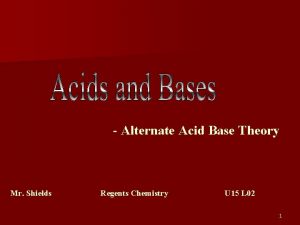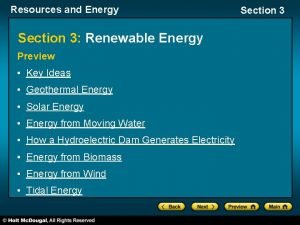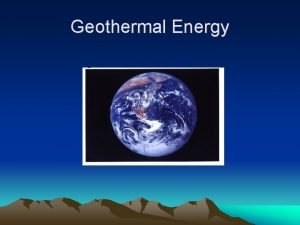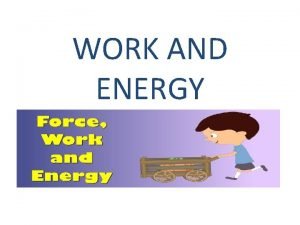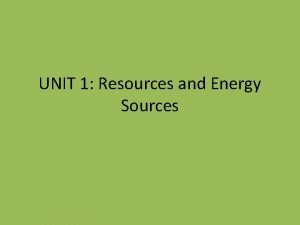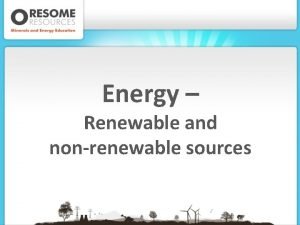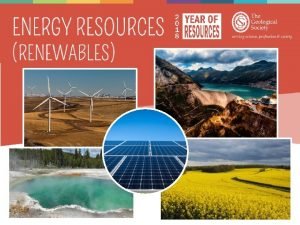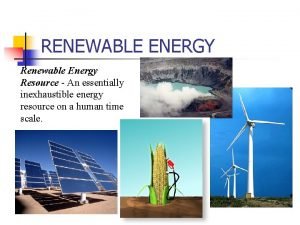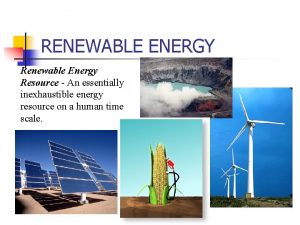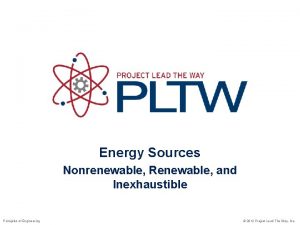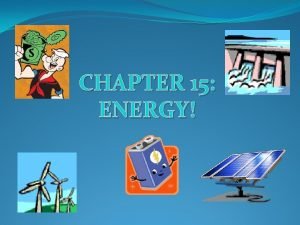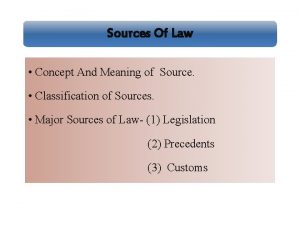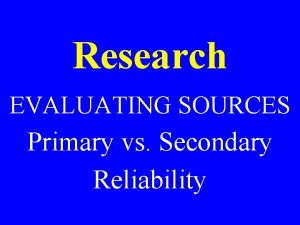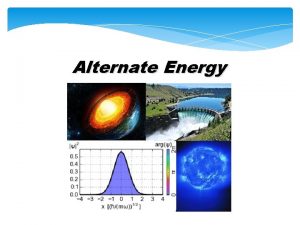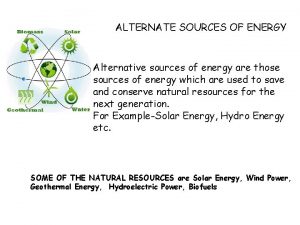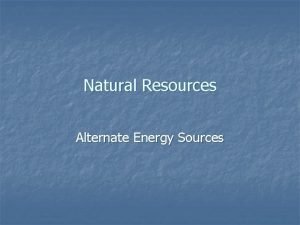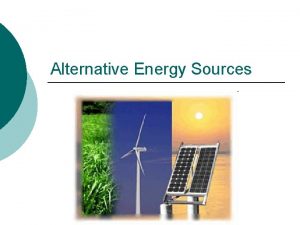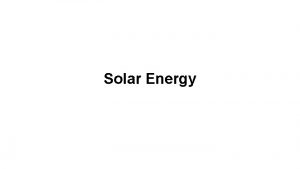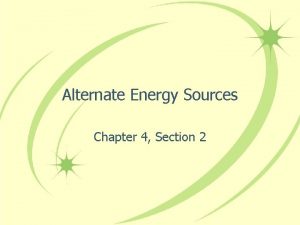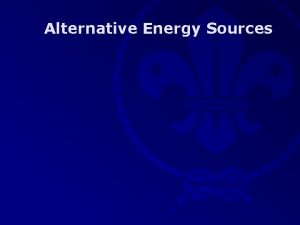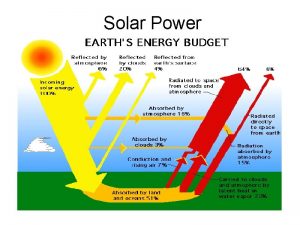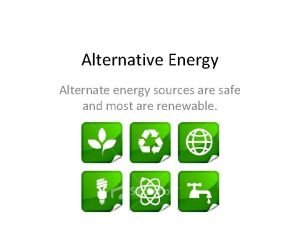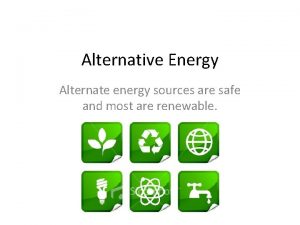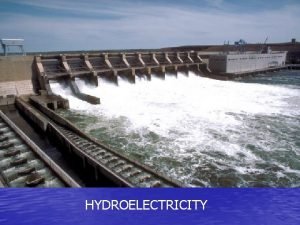ENERGY ALTERNATE ENERGY SOURCES Solar Energy Definition Of
























- Slides: 24

ENERGY ALTERNATE ENERGY SOURCES

Solar Energy • Definition Of Solar Energy – This is energy received from the sun by the Earth in the last 100 years • Hydroelectric power • Wind power – PG & E 83 MW by 1990 – SCE 43 MW by 1990 • Wood • Ocean currents • Passive and direct solar power

Solar Energy • Advantages of Solar Power – Solar energy received by the Earth is enormous 17. 7 x 1016 watts • 100, 000 x world electrical output – – – Infinite supply Constant supply No pollution No boycotts Biologically compatible

Solar Energy • Passive Solar Power – Space heating – Water heating

Solar Energy • Direct Solar - Converts Sunlight to Electricity – This is very expensive – Modern 1000 MW plant would require 42 sq. km. or 16. 2 sq. miles • 10, 000 MW input • Surface receives 0. 024 watts/cm 2 – 1010 watts/0. 024 watts/cm 2) = 42 sq. km. – A future approach might involve satellite receivers microwaving the energy to Earth

Water Power • History and Potential – Large scale generation and transmission of water power started around 1900 – Present production is 45, 000 MW • Ultimate maximum based on stream flow is 161, 000 MW • It appears that some used potential may help compensate for declining fossil fuels

Water Power • The Problems of Hydroelectric Power – Dams have a large impact on the environment – Most acceptable hydro sites are already developed – Hydroelectric power only supplies a small percent of the nations power

Tidal Power • Same Basic Principle as Hydroelectric Power • Tidal energy can be exploited in two ways: – By building semi-permeable undersea tidal turbines across estuaries with a high tidal range. – By harnessing offshore tidal streams

Tidal Power • How it works: – Water flow as basin fills or empties drives turbines – Similar to a wind turbine, but goes in both directions – Requires a daily tidal range of 5 -7 meters (~15 -21 feet) to be practical – Characterized by low capacity factors, usually in the range of 20 -35%.

Tidal Power • Locations – 240 MW facility has operated in France since 1966 – 20 MW in Canada since 1984 – A number of stations in China since 1977, totaling 5 MW

List of World Main Tidal Power Stations Country Power Station Tidal Loss (m) Capacity (MW) Operated Since France Langce 8. 5 240 1966 Canada Andeboriece 7. 1 1984 Former Soviet Union China Gicelaya 3. 9 0. 4 1968 Jiangxia 5. 1 3. 2 1980 China Baishakou 2. 4 0. 64 1978 China Xingfuyang 4. 5 1. 28 1989 China Yuepu 3. 6 0. 15 1971 China Haishan 4. 9 0. 15 1975 China Shashan 5. 1 0. 04 1961 China Liuhe 2. 1 0. 15 1976 China Guozishan 2. 5 0. 04 1977

Tidal Power • La Rance, France - world's first tidal power plant – Average tidal range 27 feet – Dam encloses 8. 5 sq. miles – Capacity is 320, 000 KW

Tidal Power • Low Production but also Low Environmental Impact – No noxious waste – No consumption of resources – Minimum disturbance to scenery

Geothermal Power • Source of the Energy – Conduction to the surface – Convection by volcanoes and hot springs

Geothermal Power • Two Methods of Recovery – Dry Steam Geothermal Fields • Steam rises to the surface and is used directly to drive a turbine • Geysers, California is an example – Produced 2000 MW by 1986 – Serves 12 cities & 2 million people around Sonoma County – Ultimate possible is 2500 MW – This type is rare

Geothermal Power • Two Methods of Recovery (continued) – Wet Steam Geothermal Power • Steam and water come to the surface and must be separated • This type is found and used in New Zealand, Japan, Mexico, Russia, & Iceland • Water may be used for conventional heating before disposal • Disposal method depends on salinity – Pour it into a river – Pipe it to the ocean for disposal – Reinject it

Geothermal Power • Recovery from Non-thermal Areas – This is more challenging and has not yet been accomplished – Drill 2 adjacent holes • Pump cold water into one • Recover steam from the other

Atomic Fusion • Possibility was first recognized by Hans Bethe 1939 - Nobel Prize) – Concept is to harness the energy of the sun by fusing 1 D 2 into 2 He 3 or 2 He 4 – This has already been done in the form of the hydrogen bomb

Atomic Fusion • Definitions – Proton – a positively charged subatomic particle – Neutron – a negatively charged subatomic particle

Atomic Fusion • Definitions – Isotope – atom that exhibits variation in its mass number – Mass number – sum of the neutrons plus the protons in an atom – Atomic number – # of protons found in the nucleus – Atomic weight – average of the atomic masses of all the element's isotopes

Atomic Fusion • Definitions – Fission – the act or process of splitting into parts – Fusion – a nuclear reaction in which nuclei combine to form more massive nuclei with the simultaneous release of energy

Atomic Fusion • The 3 Isotopes of Hydrogen – Hydrogen 1 H 1 – Deuterium 1 D 2 – Tritium 1 T 3

Atomic Fusion • The Reactions – 2 + D 2 --> He 3 + n + 3. 2 M 106 electron D 1 1 2 ev volts) • This produces a stable end product – 2 + D 2 --> T 3 + H + 4. 0 Mev D 1 1 1 • 1 T 3 is unstable and reacts with 1 D 2 – 1 D + 1 T 3 --> 2 He 4 + n + 17. 6 Mev – Total energy released is 5 1 D 2 --> 2 He 4 + 2 He 3 + H + 2 n + 24. 8 Mev 2

Atomic Fusion • How Much Resource is Available? – There is 1 1 D 2 atom per 6, 500 H atoms in sea water – One cubic meter of sea water contains 34. 4 grams 1 D 2 • Potential energy equals 269 metric tons of coal or 1, 360 barrels of oil – One cubic km of sea water equals 269 billion tons of coal or 1, 360 billion bbls oil • Exceeds the entire world oil resource
 An inexhaustible source of energy
An inexhaustible source of energy Print sources of information
Print sources of information Water management importance
Water management importance Wholesale solar energy
Wholesale solar energy Renewable energy concept
Renewable energy concept Wind energy is an indirect form of
Wind energy is an indirect form of Alternate acid theory
Alternate acid theory Section 3 renewable energy sources
Section 3 renewable energy sources Nonrenewable energy sources
Nonrenewable energy sources Potential energy
Potential energy Nonrenewable energy sources
Nonrenewable energy sources Natural sources of heat energy
Natural sources of heat energy Sources of geothermal energy
Sources of geothermal energy Mechanical energy
Mechanical energy Definition of energy resources
Definition of energy resources Non renewable resources disadvantages
Non renewable resources disadvantages Classification of energy sources
Classification of energy sources Ppt on alternative sources of energy
Ppt on alternative sources of energy Renewable energy sources are essentially inexhaustible
Renewable energy sources are essentially inexhaustible Is solar energy renewable or inexhaustible
Is solar energy renewable or inexhaustible Department of energy
Department of energy Bill nye energy quizlet
Bill nye energy quizlet What is mobile source
What is mobile source Historical source of law
Historical source of law Reliable source definition
Reliable source definition






